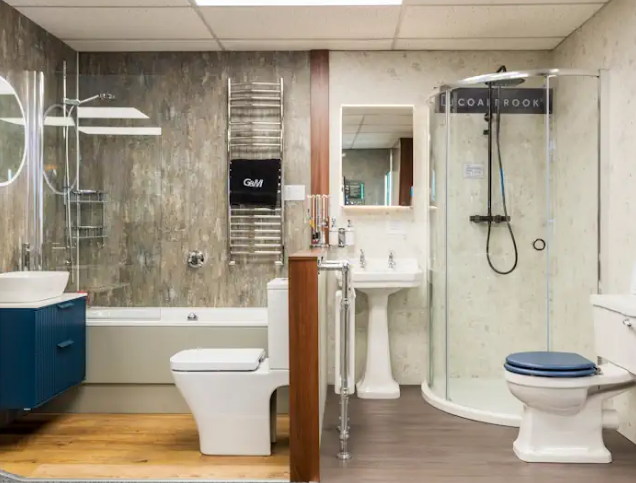Planning your bathroom installation takes more than picking out tiles and taps. Whether you’re updating a family bathroom or designing a new ensuite, every choice—from layout to lighting—affects how the space works for you. This guide covers everything you need to plan a bathroom installation that’s functional, practical, and tailored to your daily routine.
Start with How You Use Your Bathroom
Think about how you use your bathroom. A busy family bathroom needs to cope with early starts and bedtime routines. An ensuite might need space for two people to get ready at the same time. Are you after a space to relax or a layout that handles everyday demands without stress?
Be honest. If your mornings are hectic, prioritise function. If you want somewhere to unwind, factor in comfort. Your layout, fittings, and budget should all reflect your needs.
Measure Everything Before You Start
Measurements matter. Skipping this step causes delays and expensive mistakes. Grab a tape measure and write down:
- Room size (length, width, height)
- Door and window positions (and which way they open)
- Locations of existing pipes, radiators, and ventilation
- Distance between key features (e.g. toilet to basin)
- Space around entry points—especially for moving large items in
Save this information. You’ll need it when ordering products, speaking to fitters, or planning your layout.
Plan a Layout That Works
Your layout should support how you move through the space. Make sure there’s at least 70cm clearance in front of toilets and basins. Shower doors need space to open properly. Towel rails should be within reach of the bath or shower.
Tips for a better layout:
- Avoid putting the toilet directly in view of the door
- Keep storage where you’ll use it—near the mirror, under the sink
- Leave room for a bin or laundry basket
- Place mirrors where they catch natural light
- Make sure nothing blocks access to sockets or switches
Research by the Bathroom Manufacturers Association shows poor layouts are a top frustration. Get this part right and the rest follows.
Know Your Plumbing System
Your water system determines what fittings you can use. Before choosing showers or taps, check which system your home has:
- Gravity-fed(tank in loft, cylinder in airing cupboard)
- Combi boiler(no tank, heats water on demand)
- Unvented(pressurised cylinder, good water pressure)
Water pressure varies. A rainfall shower needs good pressure—if yours is low, you’ll need a pump or a different type of fitting. A plumber can confirm what your system can handle.
Choose Materials That Last
Go for materials that handle daily use and are easy to clean. Think long-term, not just looks.
| Material | Benefits | Best For |
| Porcelain | Strong, waterproof | Floors, wall tiles |
| Natural stone | Durable, unique | Feature walls, counters |
| Glass | Brightens space, easy to wipe | Shower screens, accents |
| Solid surface | Seamless, repairable | Worktops, wet walls |
Use textured tiles or slip-resistant flooring to reduce the chance of slipping. Avoid porous materials in wet zones unless they’re sealed properly.
Get Lighting Right
Bathroom lighting needs to be practical and flexible. Use a mix of lighting types:
- Task lighting for mirrors
- Ambient lighting for general use
- Accent lighting if you want to highlight features
Put lights on separate circuits so you can control the mood. Always choose lights with the correct IP rating for bathrooms—especially near showers and baths. Ask your electrician to follow current UK safety regulations.
Add Smart Storage
Storage keeps your bathroom usable and clutter-free. Use wall space with tall cabinets or shelving. Choose a vanity with drawers to hide everyday essentials. Built-in alcoves in shower areas help keep bottles off the floor. If space is tight, consider mirrored cabinets for double use.
What to Expect During Installation
Bathroom installations usually follow this order:
- Strip out– Removing your old bathroom
- First fix– Plumbing and wiring
- Waterproofing and tiling– Preparing surfaces
- Second fix– Fitting the bath, shower, toilet, sink
- Final checks– Testing systems and checking finishes
A full bathroom renovation usually takes 7 to 10 working days, but delays can happen—especially if you’re moving pipes or waiting on materials.
Budgeting Tips That Save Hassle
A realistic budget avoids stress later. Here’s what to factor in:
- 15–20% for unexpected costs
- Labour (this often matches or exceeds product costs)
- Disposal of old fixtures and waste
- Electrical work and plastering if needed
- Higher quality for items you use daily (toilet, taps, shower)
If you’re changing layout, expect higher plumbing costs. Talk to your installer early so you know what’s possible and what it’ll cost.
Ready to Plan Your Bathroom?
If you’re based in or around Colchester, visit the G&M showroom to see the latest bathroom styles and talk to our team. You can also download our free bathroom planner to start mapping out your space. When you’re ready, we’ll help you turn your ideas into a practical, finished bathroom.

